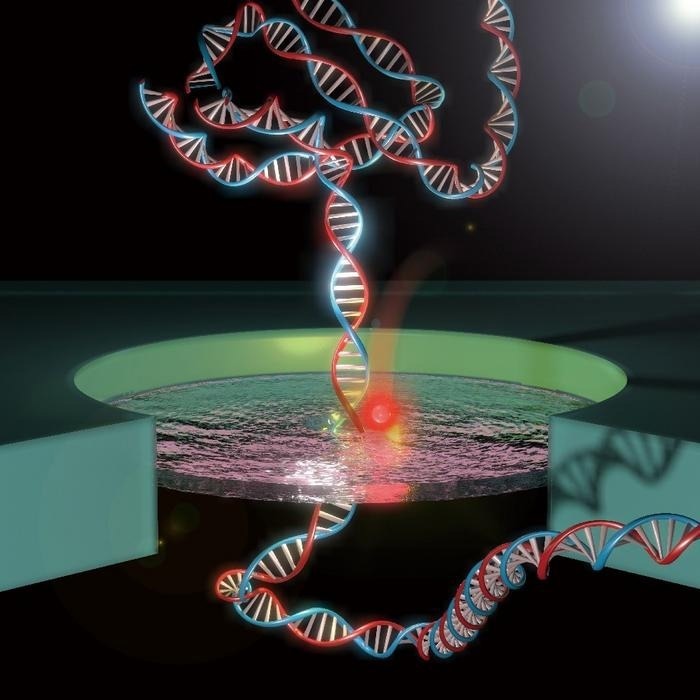Reviewed by Lexie CornerFeb 6 2025
Researchers from Osaka University have developed a nanogate that can be electrically controlled to open or close. The behavior of the nanogate is influenced by the applied voltage and the composition of solutions on either side, making it suitable for applications such as sensing and controlled chemical reactions.
 Schematic model depicting single molecule DNA translocating through a nanoprecipitated nanopore. Image Credit: Makusu Tsutsui
Schematic model depicting single molecule DNA translocating through a nanoprecipitated nanopore. Image Credit: Makusu Tsutsui
At the nanoscale, gates regulate the movement of individual molecules, similar to how a farm gate controls livestock movement at the macroscale. The nanogate consists of a single nanoscale pore within a silicon nitride membrane. The membrane was placed inside a flow cell on a chip, with solutions introduced on both sides.
By applying voltage through electrodes on the chip, the researchers measured the resulting ionic current, which reflected ion movement through the pore. The ionic current, sensitive to ion concentrations in both solutions, enabled precise control over ion transport and the precipitation or dissolution of metal compounds within the pore.
Changes in pore diameter due to precipitation (closing the nanogate) or dissolution (opening the nanogate) altered ion transport characteristics.
Precipitates grew and closed the pore under negative voltage, decreasing ionic current. Inverting the voltage polarity caused the precipitates to dissolve, reopening the pore.
Makusu Tsutsui, Study Lead Author, Osaka University
Under specific conditions, when a precipitate formed and blocked the pore, the system achieved the highest rectification ratio reported for a nanofluidic device, indicating a strong directional preference for ion movement.
Additionally, the system exhibited memristive behavior, where a memory effect was observed in the voltage-current relationship. This effect resulted from sequential precipitation and dissolution within the pore.
The nanogate also demonstrated potential for biomolecule detection. Using DNA as a test case, the system produced distinct output signals as individual DNA molecules passed through the pore, highlighting its capability for molecular sensing.
The ability to finely control pore size using applied voltage should allow pores to be tailored for specific analytes immediately before conducting measurements. We also anticipate that our approach can be used to develop reaction systems to access new chemical compounds.
Tomoji Kawai, Study Senior Author, Osaka University
Using a single controlled pore in nanofluidic electrochemical devices offers a versatile approach for applications in chemical reaction control, neuromorphic computing, and molecular sensing.
Journal Reference:
Tsutsui, M., et al. (2025) Transmembrane voltage-gated nanopores controlled by electrically tunable in-pore chemistry. Nature Communications. doi.org/10.1038/s41467-025-56052-0.